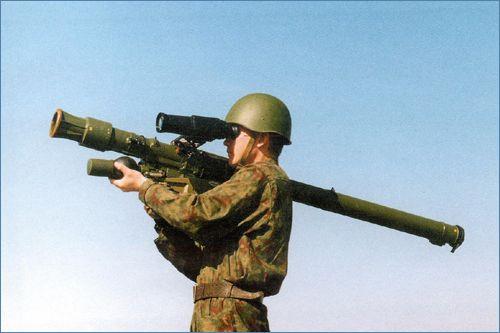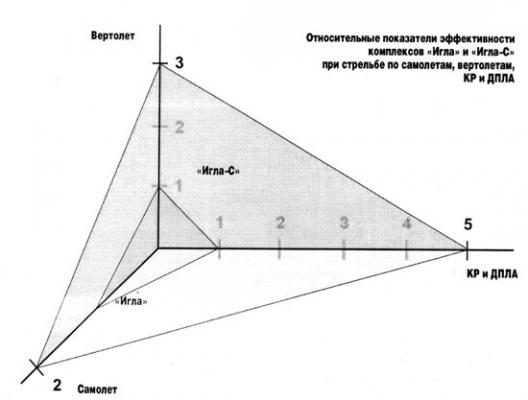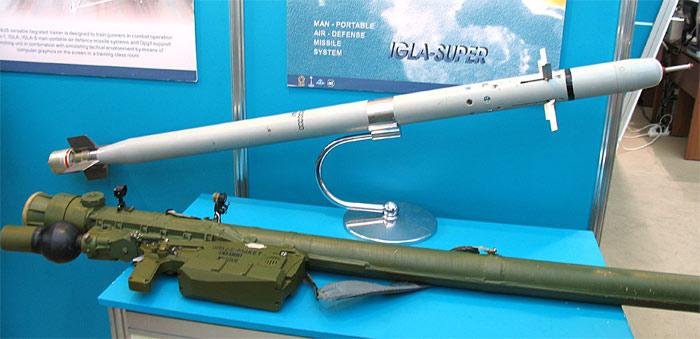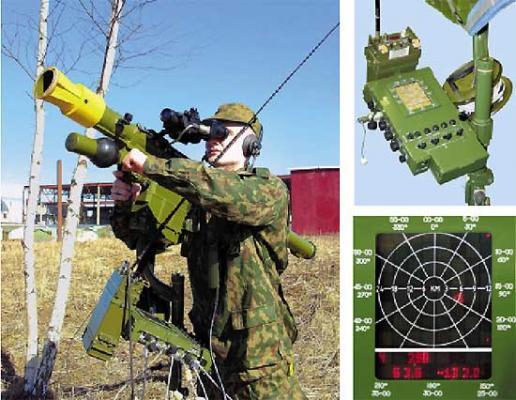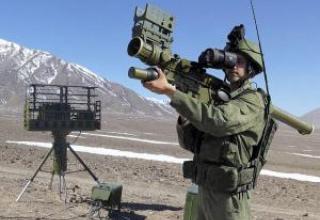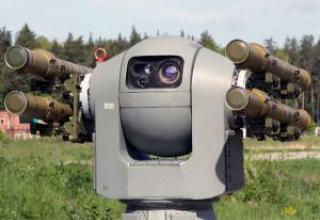The 9K338 Igla-S portable anti-aircraft missile system is designed to engage low-flying air targets of various types on counter and overtaking courses in conditions of natural (background) and artificial thermal interference.
The complex is the result of a deep upgrade of 9K38 Igla man-portable air defence systems and has a wider range of capabilities to combat both traditional air targets such as aircraft and helicopters, replacing two or three needle-type man-portable air defence systems and new cruise missiles, while replacing expensive and small anti-aircraft systems.
The developer of the complex is the Mechanical Engineering Design Bureau (Kolomna). The development of homing heads for the complex is carried out by the "Leningrad Optical and Mechanical Association" (LOMO). The manufacturer is "Degtyarev Plant" (Kovrov).
The state tests of the Igla-S complex were completed in December 2001.
Igla-S" man-portable air defence systems can be used as a part of various ground, sea and air-based carriers. This opens up prospects for the development of lightweight mobile guided missile weapon systems. On the one hand, this is due to the light weight and dimensions of the missiles, which allow for a significant increase in the ammunition and firepower of the carrier, and on the other hand, due to its technical characteristics, the Igla-S man-portable air defence system is close to the level of short-range anti-aircraft systems and is capable of carrying out broader missions.
In 2002, Russia handed over 50 Igla-S man-portable air defence systems to Vietnam under a $64 million contract concluded in autumn 2001.
Composition:
Functionally, complex 9K338 "Needle-C" includes the following components:
-
materiel (see diagram) in the composition :
- 9M342 missile in tube 9P338 with ground power source 9B238-1 (9B238);
- launch mechanism 9P522;
- maintenance facilities in the composition:
- mobile control point 9B866-2;
- set of control and testing equipment 9F719-2;
- firing means - night vision sight "Maugli-2" 1ПН97.
The difference between the Igla-S complex and the prototype is in the increased range of fire (up to 6 km), increased power of the combat unit (both in terms of mass of explosives and number of fragments) with practically unchanged weight of the missile itself, in the effectiveness of action on air targets highly protected from air defense means.
During the creation of man-portable air defence systems in the LOMO group, the interference-resistant SNS 9E435 was developed. The use of two photo receivers operating in different spectral ranges in the homing head (Homing Head) allowed to provide a selection of thermal interference. In addition, in the homing head introduced the so-called "drift pattern", which provides the formation of control commands on the steering wheel of the missile in the approaching target so that the missile deviates from the point of guidance, located in the nozzle area to the center of the target, ie in the most vulnerable units. According to the developers' information, this SOS has record characteristics in terms of vibration sensitivity and impact resistance.
The Igla-S man-portable air defence system is the first of its kind to use a non-contact target sensor in a missile of this class, which provides for the detonation of a combat unit when flying close to a target, which happens when shooting at small targets. The task is not only to introduce a non-contact target sensor into a combat unit, but also to ensure its optimal operation with a contact fuse. This is achieved by introducing a certain delay in detonating the combat unit after the non-contact target sensor is triggered. If a contact sensor detonates during this delay time, the operation of the non-contact sensor is blocked and the unit is detonated according to the algorithm of the contact blast. Thus, for example, when firing on an aircraft (a large-sized target) the delay is set intentionally large, because when the missile flies against structural elements of the aircraft, the non-contact sensor will trigger, but the detonation of the combat unit in this place will be ineffective; during the delay time, the missile will approach the aircraft hull and the combat unit will be detonated by the contact sensor, if this does not happen, then after the delay time the combat unit will explode. It should be noted that the delay times in the missile are set automatically, depending on the modes of operation.
The missile's dimensions and weight limitations require a relatively small combat unit with maximum effectiveness. Increased effectiveness in engaging air targets is achieved through a buried contact blast of the warheads, with the level of burial adapted to the speed of encountering the target. Russian specialists solved this problem by creating a "smart" fuse, which, having received information about the missile's impact on the target, waits for information from the penetration sensor (there is such a sensor) of the combat unit in the shell of the aircraft and, taking into account the time of receiving these signals, gives the command to detonate. As a result, a small man-portable air defence system warhead causes significant damage to the aircraft.
To increase the effectiveness of the combat unit, the solid propellant charge of the marching engine is made of material capable of detonation by the detonation of the combat unit. Such a solution, which despite its simplicity has not yet been replicated abroad, has made it possible to dramatically increase the effectiveness of man-portable air defence systems firing on the counter course in the area of the kill zone by 1...3 km, i.e. the most probable area where the missile meets the target.
After the missile departs from the launch tube, a gunpowder control engine starts to operate, turning the missile into a preemptive point without human intervention.
A removable night vision sight (NWS) 1ПН72М "Maugli" is added to the man-portable air defense system. which allows the use of man-portable air defence systems in night conditions, providing target detection and identification by a anti-aircraft gunner, aiming and escorting the target prior to missile launch. Given that nighttime raids have recently become ubiquitous during combat operations, the presence of man-portable air defence systems significantly enhances the complex's capabilities.
The needle-C, needle-1 and needle have been maintained at a high level of continuity. The dimensions of the new man-portable air defence systems, their fixation places and package dimensions have remained the same. The Igly-S rocket can be placed in the existing locations of the former rockets and installed on the previously created for missiles complexes "Igly-1" and "Igly" launchers. The Igla-S man-portable air defence system provides for the launch of Igla-1 and Igla missiles, while the Igla-S system has almost no limitations. The Mowgli MANPADS includes fasteners that enable it to be mounted on Igla-1 and Needle systems.
Igla-S" man-portable air defence systems retain the following order: preparation of combat vehicles for firing, performance of combat operations, maintenance. Thus, a trained anti-aircraft gunner does not need to undergo retraining to work with the new complex. Training simulators created for the Igloi-S complex can be used in the training process for new anti-aircraft gunners. At the same time, a new class universal complex simulator Konus was created for Igloi-S man-portable air defense systems for training and coaching anti-aircraft gunners to detect, aim and launch missiles at various types of targets at counter and overtaking courses. It consists of training facilities not only for Igla-S complex missiles, but also for Igla-1 and Igla complexes.
Igla-S" man-portable air defence systems reliably operate under conditions of extreme temperatures and high humidity (up to 98%), with sharp drops in ambient temperature and with condensed precipitation, after submergence in water (at a depth of 0.5 m for half an hour) and lifting in an airtight cockpit to a height of 12 km, after long transportation by any means of transport, including vehicles and tracked vehicles, on any types of roads and off-road. When packaged, it shall be permissible for combat vehicles to drop from a height of up to 2 m on a concrete base, and they shall remain fit for further combat use. The complex combat vehicles can be subjected to accidental broadband vibration and multiple mechanical shocks (up to 35g). They are resistant to dust, hoarfrost, dew, salty sea fog, cyclic impact of temperatures (with an instantaneous drop from +50°C to -50°C and back), solar radiation, rain and low atmospheric pressure, they are not afraid of the impact of mold fungi, marine flora, ants, termites and rodents.
The rocket can be launched by a anti-aircraft gunner from any unprepared open area, from a trench, from the body of a moving vehicle, from a railway platform and even from a water body.
The assigned service life of the combat means of the complex in the Russian Army when stored in heated premises in boxes 9Y710, 9P522.55.000 is ten years, including seven years in unheated premises, of which four years in field conditions when stored in boxes, including two years of military operation outside the boxes.
In order to improve the effectiveness of the Igla-S man-portable air defence systems, a 9C520 Night Shooting Assistortment System (SASN) has been developed. This kit can be used for all types of portable anti-aircraft missile systems. It enables the commander of the anti-aircraft gunner's office to receive alerts about air targets, carry out target distribution between shooters and then, after detecting an air target, carry out aiming, escorting, homing head grabbing and launching the missile. SOSN 9C520 provides:
- reception of telcode information from control stations of the following types: "Assembling" (9C-80M), "Ranzhir". (9C737), PU-12 (9C482M6, M7), MP-22R, ROLL N-19 (1RL134SH3);
- indication on the light-indicator of the portable electrotronic tablet (PEP) of the target location with the signs of state ownership and composition;
- introduction of topogeodetic reference in PEP, including space reference;
- orientation of the magnetic azimuth bearing devices;
- recalculation of current coordinates of the targets displayed on CEP to the point of location of anti-aircraft gunners;
- address transmission over the cable at a distance of up to 50 m of target distribution information and the current value of target designation to the anti-aircraft gunners by azimuth and range to the target;
- searching, detecting and aiming man-portable air defence systems at air targets at any time of day or night;
- increasing the probability and range of target detection at any time of day;
- the physical and psychological relief of the anti-aircraft gunner on combat duty and during combat;
SOS 9C520 contains:
- portable electronic tablet, which includes a radio station and a microelectronic terminal designed to convert the telecode information coming from the control room type 9C482M4, display on the indicator of target location with signs of state ownership and composition of targets (single-group), target distribution and issuance of target designation to the support device;
- a group of support devices spaced at a distance of up to 50 m from each other (see photo), each of which is made in the form of a folding tripod and a rack with man-portable air defence system elements and is equipped with individual target designation means connected to a microelectronic terminal by separate communication lines;
- individual means of CC, having an angular position sensor, electronic units, 1ПН72М night vision sight. This makes it possible to bring to the anti-aircraft gunner the information about the appearance of an air target, its movement direction and range;
- special packages for storage, carrying and transportation (by all means of transport) of the pine arms components.
Continuous operation time from one set of autonomous power supplies is at least 12 hours, from on-board power supplies - without limitation.
In 2009 a new version of the SOSN kit - 9C935 Barnaul, developed by JSC "Izmeritel" (Smolensk), came into service.
The Igla-S man-portable air defence system is paired with the Gigit support and launch system, the Sagittarius set of control equipment and launch modules, the Komar turret system.
Characteristics:
| Igla-S man-portable air defence systems | ||
| Defeat zone, m: - at a distance - in height |
6000 10 - 3500 |
|
| Speed of targets to be hit, m/s: - towards - inhalation |
400 320 |
|
| Mass of combat vehicles in combat position, kg | 19 | |
| Rocket caliber, mm | 72 | |
| The length of the rocket, mm | 1635 | |
| Mass of the rocket, kg | 11. 7 | |
| Weight BC, kg | 2.5 | |
| Time to transfer man-portable air defence systems from camping to combat, sec | 13 | |
| Time to transfer man-portable air defence systems from combat to camping , sec | 30 | |
| Operating time of the onboard battery of the rocket, sec | not less than 15 | |
| Power supply change time, sec | 15 | |
| Conditions of use: - temperature, deg.C - air humidity - submergence in water - depth - airtight cab - dropping onto concrete - overpackaging |
between -40 and +50 up to 98% 0.5 m for 30 min up to 12000m from a height of up to 2 m up to 35g |
|
| SUSN 9C520 | ||
| Air display area, km | 25.6х25.6 | |
| Number of targets simultaneously displayed on PEP and transmitted to individual target designation means, pcs. | for 4 | |
| Selection of PEP 1L10-2 targets for escort | feature-based automatic | |
| Probability of detection of targets such as "airplane", "helicopter" on a counter course in lighting conditions 3х10-3 to the point of 2 km | 0.6 | |
| Power supply voltage, V | 12, 24±3 | |
| Temperature range, deg.C. | between -50 and +50 | |
| Weight SOSN 9C520 in packs (3 boxes), kg | not more than 120 | |
Testing:
During the war with Iran, Iraq used HOT missiles, launching them from ground armored vehicles as well as helicopters. In the 1980s. "HOT was used in Lebanon by Syrians who destroyed several Israeli tanks such as Merkava. The complex was used by multinational forces during Operation Desert Storm.
